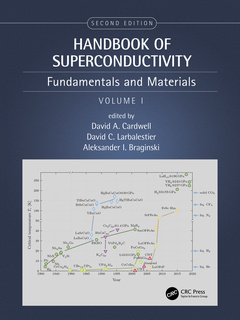Description
Handbook of Superconductivity (2nd Ed.)
Fundamentals and Materials, Volume One
Coordinators: Cardwell David A., Larbalestier David C., Braginski Aleksander
Language: English
Subjects for Handbook of Superconductivity:
Keywords
Organic Superconductors; Heavy Fermion Superconductors; Cuprate Superconductor; YBCO; Fermi Surface; Critical Current Density; Iron Based Superconductors; Flux Lines; Cooper Pairs; Meissner Effect; HTS; Magnetic Penetration Depth; Ginzburg Landau Theory; Superconducting State; Coherence Length; HTS Material; Josephson Junction; Conventional Superconductor; Isotope Effect; Penetration Depth; High Temperature Superconducting Cuprates; Flux Quantum; Superconducting Coherence Length; Low Temperature Superconductors; Flux Pinning
· 21x28 cm · Hardback
Description
/li>Contents
/li>Biography
/li>
This is the first of three volumes of the extensively revised and updated second edition of the Handbook of Superconductivity. The past twenty years have seen rapid progress in superconducting materials, which exhibit one of the most remarkable physical states of matter ever to be discovered. Superconductivity brings quantum mechanics to the scale of the everyday world where a single, coherent quantum state may extend over a distance of metres, or even kilometres, depending on the size of a coil or length of superconducting wire. Viable applications of superconductors rely fundamentally on an understanding of this intriguing phenomena and the availability of a range of materials with bespoke properties to meet practical needs. This first volume covers the fundamentals of superconductivity and the various classes of superconducting materials, which sets the context and background for Volumes 2 and 3.
Key Features:
- Covers the depth and breadth of the field
- Includes contributions from leading academics and industry professionals across the world
- Provides hands-on guidance to the manufacturing and processing technologies
A comprehensive reference, this handbook is suitable for both graduate students and practitioners in experimental physics, materials science and multiple engineering disciplines, including electronic and electrical, chemical, mechanical, metallurgy and others.
Foreword. Preface. Acknowledgements. Editors-in-Chief. Contributors. Part A Fundamentals of Superconductivity. A1 Introduction to Section A1: History, Mechanisms and Materials. A1.1 Historical Development of Superconductivity. A1.2 An Introduction to Superconductivity. A1.3 The Polaronic Basis for High-Temperature Superconductivity. A2 Introduction to Section A2: Fundamental Properties. A2.1 Phenomenological Theories. A2.2 Microscopic Theory. A2.3 Normal-State Metallic Behavior in Contrast to Superconductivity: An Introduction. A2.4 The Meissner–Ochsenfeld Effect. A2.5 Loss of Superconductivity in Magnetic Fields. A2.6 High-Frequency Electromagnetic Properties. A2.7 Flux Quantization. A2.8 Josephson Effects. A2.9 Other Josephson-Related Phenomena. A3 Introduction to Section A3: Critical Currents of Type II Superconductors. A3.1 Vortices and Their Interaction. A3.2 Flux Pinning. Part B Low-Temperature Superconductors. B Introduction to Section B: Low-Temperature Superconductors. B1 Nb-Based Superconductors. B2 Magnesium Diboride. B3 Chevrel Phases. Part C High-Temperature Superconductors. C Introduction to Section C: High-Temperature Superconductors. C1 YBCO. C2 Bismuth-Based Superconductors. C3 TIBCCO. C4 HgBCCO. C5 Iron-Based Superconductors. C6 Hydrides. Part D Other Superconductors. D Introduction to Section D: Other Superconductors. D1 Unconventional Superconductivity in Heavy Fermion and Ruthenate Materials. D2 Organic Superconductors. D3 Fullerene Superconductors. D4 Future High-Tc Superconductors. D5 Fe-Based Chalcogenide Superconductors. D6 Interface Superconductivity. D7 Topological Superconductivity. Glossary. Index.
These books may interest you

Superfluid States of Matter 208.65 €

Superfluid States of Matter 56.31 €

